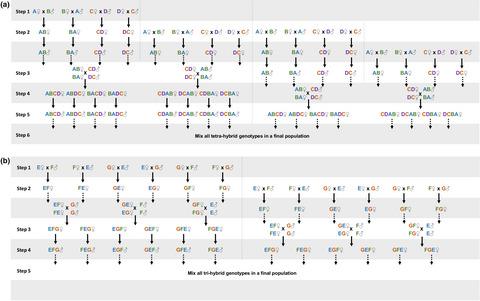当前位置:
X-MOL 学术
›
Ecol. Evol.
›
论文详情
Our official English website, www.x-mol.net, welcomes your
feedback! (Note: you will need to create a separate account there.)
Creating outbred and inbred populations in haplodiploids to measure adaptive responses in the laboratory.
Ecology and Evolution ( IF 2.3 ) Pub Date : 2020-07-07 , DOI: 10.1002/ece3.6454 Diogo P Godinho 1 , Miguel A Cruz 1 , Maud Charlery de la Masselière 1 , Jéssica Teodoro-Paulo 1 , Cátia Eira 1 , Inês Fragata 1 , Leonor R Rodrigues 1 , Flore Zélé 1 , Sara Magalhães 1
Ecology and Evolution ( IF 2.3 ) Pub Date : 2020-07-07 , DOI: 10.1002/ece3.6454 Diogo P Godinho 1 , Miguel A Cruz 1 , Maud Charlery de la Masselière 1 , Jéssica Teodoro-Paulo 1 , Cátia Eira 1 , Inês Fragata 1 , Leonor R Rodrigues 1 , Flore Zélé 1 , Sara Magalhães 1
Affiliation

|
Laboratory studies are often criticized for not being representative of processes occurring in natural populations. One reason for this is the fact that laboratory populations generally do not capture enough of the genetic variation of natural populations. This can be mitigated by mixing the genetic background of several field populations when creating laboratory populations. From these outbred populations, it is possible to generate inbred lines, thereby freezing and partitioning part of their variability, allowing each genotype to be characterized independently. Many studies addressing adaptation of organisms to their environment, such as those involving quantitative genetics or experimental evolution, rely on inbred or outbred populations, but the methodology underlying the generation of such biological resources is usually not explicitly documented. Here, we developed different procedures to circumvent common pitfalls of laboratory studies, and illustrate their application using two haplodiploid species, the spider mites Tetranychus urticae and Tetranychus evansi . First, we present a method that increases the chance of capturing high amounts of variability when creating outbred populations, by performing controlled crosses between individuals from different field‐collected populations. Second, we depict the creation of inbred lines derived from such outbred populations, by performing several generations of sib‐mating. Third, we outline an experimental evolution protocol that allows the maintenance of a constant population size at the beginning of each generation, thereby preventing bottlenecks and diminishing extinction risks. Finally, we discuss the advantages of these procedures and emphasize that sharing such biological resources and combining them with available genetic tools will allow consistent and comparable studies that greatly contribute to our understanding of ecological and evolutionary processes.
中文翻译:

在单倍二倍体中创建远交和近交种群,以在实验室中测量适应性反应。
实验室研究经常因不能代表自然群体中发生的过程而受到批评。造成这种情况的原因之一是实验室群体通常无法捕获足够的自然群体的遗传变异。在创建实验室群体时,可以通过混合多个野外群体的遗传背景来缓解这种情况。从这些远交群体中,可以产生近交系,从而冻结和划分其部分变异性,从而使每个基因型能够独立表征。许多涉及生物体适应环境的研究,例如涉及定量遗传学或实验进化的研究,都依赖于近交或远交种群,但通常没有明确记录产生此类生物资源的方法。在这里,我们开发了不同的程序来规避实验室研究的常见陷阱,并使用两种单倍二倍体物种(二斑叶螨和伊氏叶螨)来说明其应用。首先,我们提出了一种方法,通过在来自不同现场采集种群的个体之间进行受控杂交,在创建远交种群时增加捕获大量变异的机会。其次,我们通过进行几代同胞交配来描述从此类远交种群衍生的近交系的创建。第三,我们概述了一个实验性进化协议,该协议允许在每一代开始时维持恒定的种群规模,从而防止瓶颈并减少灭绝风险。最后,我们讨论了这些程序的优点,并强调共享此类生物资源并将其与可用的遗传工具相结合将允许进行一致和可比的研究,这极大地有助于我们对生态和进化过程的理解。
更新日期:2020-07-30
中文翻译:

在单倍二倍体中创建远交和近交种群,以在实验室中测量适应性反应。
实验室研究经常因不能代表自然群体中发生的过程而受到批评。造成这种情况的原因之一是实验室群体通常无法捕获足够的自然群体的遗传变异。在创建实验室群体时,可以通过混合多个野外群体的遗传背景来缓解这种情况。从这些远交群体中,可以产生近交系,从而冻结和划分其部分变异性,从而使每个基因型能够独立表征。许多涉及生物体适应环境的研究,例如涉及定量遗传学或实验进化的研究,都依赖于近交或远交种群,但通常没有明确记录产生此类生物资源的方法。在这里,我们开发了不同的程序来规避实验室研究的常见陷阱,并使用两种单倍二倍体物种(二斑叶螨和伊氏叶螨)来说明其应用。首先,我们提出了一种方法,通过在来自不同现场采集种群的个体之间进行受控杂交,在创建远交种群时增加捕获大量变异的机会。其次,我们通过进行几代同胞交配来描述从此类远交种群衍生的近交系的创建。第三,我们概述了一个实验性进化协议,该协议允许在每一代开始时维持恒定的种群规模,从而防止瓶颈并减少灭绝风险。最后,我们讨论了这些程序的优点,并强调共享此类生物资源并将其与可用的遗传工具相结合将允许进行一致和可比的研究,这极大地有助于我们对生态和进化过程的理解。











































 京公网安备 11010802027423号
京公网安备 11010802027423号